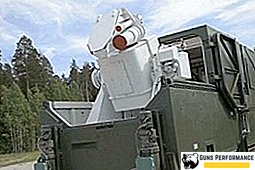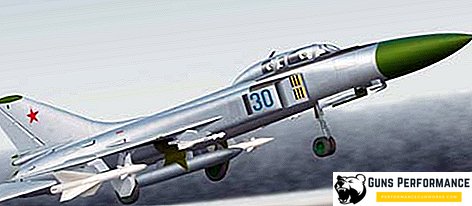The anti-tank missile system Fagot belongs to the second-generation anti-tank systems, it is the first domestic model of such weapons with a semi-automatic control system. The development of this complex began in the 60s of the last century, it is still in service with the Russian army, it is being exploited in dozens of other armies of the world.
The anti-tank guided missile (ATGM) of this complex has been modernized several times, the Fagot has been involved in many conflicts, it has established itself as an effective and reliable weapon.

History of creation
The first work in the field of creating anti-tank guided missiles (ATGM) took the Germans during the Second World War. They created a fundamentally new weapon against armored vehicles: ATGM X-7 Rotkappchen ("Little Red Riding Hood"). This rocket was controlled by wire and had a range of 1200 meters. This missile system was ready at the very end of the war, but there is no evidence of its actual combat use.
It is not known whether the "Little Red Riding Hood" fell into at least one of the enemy tanks, but it fell into the hands of the allies for sure and had a serious impact on the further development of such weapons.
A few years after the war, the French created quite good anti-tank systems SS-10 and SS-11. The USSR joined this race not immediately, only after the successful use of anti-tank missile systems in several conflicts, and Soviet designers began developing them.
Already in 1963, the Malyutka ATGM was adopted by the Soviet Army. This complex has turned out so successful that it is used today. His “finest hour” was the Arab-Israeli war of 1973, during which up to 800 units of Israeli armored vehicles were destroyed by portable “Baby” complexes.

ATGM "Baby" (like the SS-10) belonged to the first generation of anti-tank missiles. The rocket was controlled by wire, despite all its undoubted advantages, this portable complex had many drawbacks. The rocket’s flight speed was very low: at a distance of two kilometers, the rocket flew for almost two minutes. During this time, the goal could change its location or hide behind cover. And the deployment of the complex in the combat position took too much time.
But the main drawback was another: the operator during the entire flight of the rocket had to carefully direct it to the target. That is why the results of firing at the range were very different from the results of the complex in combat conditions. The slightest trembling of the operator’s hands led the ATGM off target. The Israelis very quickly understood this lack of a complex and changed their tactics: immediately after the launch, the squall fire was opened by the operator, as a result of which the accuracy of the “Baby” was significantly reduced.
In addition, very soon, hinged dynamic armor appeared on the tanks, which immediately made the use of these ATGMs much less effective. It was necessary to create a new complex. The main task of the designers was to simplify the targeting of the rocket and increase its speed of flight.
In the second-generation ATGM, a special infrared direction finder was used to control the flight of an anti-tank missile, which monitored the position of the missile, sent information to the computer complex, and she transmitted commands to the missile through a wire that unwound behind it.

In 1963, the development of the second generation Fagot ATGM began in the Tula Instrument Engineering Design Bureau. The main difference between this rocket complex was a semi-automatic guidance system. In order to hit the target, the operator needed to just aim the sight at her and hold it throughout the entire rocket flight. The rocket flight control was performed by the automatics of the complex.
In addition, in order to reduce the deployment time, the Fagot rocket was launched directly from the container, and the launch of its main engines took place at a sufficient distance from the operator. The designers managed to seriously reduce the size and weight of the launch canister by installing the wings on the rocket, which are deployed immediately after launch.
Factory tests began in 1967 and lasted two years, in 1970 the anti-tank missile system "Fagot" was adopted.
In 1975, for the Fagot, an upgraded 9M111M missile with improved armor penetration and increased range was created.
Complex "Fagot" actively exported, and today it is in service with several dozen armies. "Fagot" managed to participate in many conflicts, while showing high efficiency and reliability. In addition to the Soviet Union, these complexes were also produced in Bulgaria.
In 2018, from such a complex, the Hussites in Yemen destroyed the modern American tank M1 Abrams, which belonged to Saudi Arabia.
According to the classification of NATO countries, this ATGM is called the AT-4 Spigot.
Description
Each complex consists of a launcher with control equipment, a trigger mechanism and a 9M111 rocket (or its modifications) in a fiberglass container. Starting container is disposable.
The 9P56M launcher can also be used to launch the "Competition" and "Konkurs-M" ATGMs. The machine consists of a swivel and tripod, as well as turning and lifting mechanisms. The complex includes a 9P155 trigger mechanism. The control unit 9С451 receives a signal from the lamp, reflected in a special mirror and determines the position of the rocket in space.

The equipment of the complex allows detecting and tracking the target, launching an ATGM, determining the location of the rocket on the entire flight trajectory and controlling its movement.
Launch container with a rocket is a fiberglass pipe, with removable front and rear covers.
The 9M111 missile is made on an aerodynamic "duck" scheme; it has a length of 900 mm and a caliber of 120 mm. The steering wheels are located in front of the rocket. The ATGM consists of four parts:
- electromagnetic drive steering;
- combat unit (CU);
- propulsion system;
- control equipment compartment.
In the tail of the rocket are bearing surfaces that unfold after launch. They are made of thin steel sheets that twist around the rocket body before installing it in a container. After launch, they self-reveal.
The ATGM is equipped with a single-chamber jet engine with two nozzles, as well as an expelling charge, which takes the rocket out of the container and sets its initial velocity. In the equipment compartment there is a control unit, an inertialess coil with a wire of 2000 or 2500 meters long, a coordinator and a headlight lamp. The headlight lamp is equipped with a special light filter that converts most of the light into infrared radiation. The lamp-headlight and the reflector are protected from the action of the expelling charge by special curtains, which are opened after the launch of the rocket propulsion engines.
In flight, the rocket is stabilized by rotation. The change of position in space is due to the swiveling nasal rudders. The composition of the control equipment includes a gyroscope, which is unwound by a powder charge.
The complex is equipped with a manual start mechanism and fuse. The "Fagot" sight has a range of four thousand meters, this ATGM can be equipped with the Mulat thermal sight, capable of detecting tanks at a distance of 3600 meters.

ATGM "Fagot" is easy to use, it is easily transferred and installed by the calculation, consisting of two people. The crew commander carries the folded launch complex, its weight is 22.5 kg, and the second number carries a bale with two missiles in launch containers. The weight of this bale is 26.85 kg.
The deployment time of the complex is 2.5 minutes.
Specifications
Below are the TTX antitank guided complex "Fagot."
| Rockets | 9M111 | 9M111M |
| Firing range, m | 70-2000 | 75-2500 |
| Rate of fire, shots / min. | 3 | 3 |
| Average speed, m / s | 186 | 180 |
| Maximum flight speed, m / s | 240 | 240 |
| Sizes, mm: | ||
| - caliber | 120 | 120 |
| - length | 863 | 910 |
| - wingspan | 369 | 369 |
| Container dimensions, mm: | ||
| - length | 1098 | 1098 |
| - width | 150 | 150 |
| - height | 205 | 205 |
| Rocket weight, kg: | ||
| - in TPK | 13 | 11,3 |
| - without TPK | 13,2 | 11,5 |
| Weight of the warhead | 2,5 | 2,5 |
| Penetration, mm | 400 | 460-500 |
| Penetration (60 °), mm | 200 | 230 |












